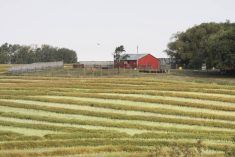For more on ATV safety courses:
All terrain vehicles are fun for children to ride but should not be treated like toys, a certified ATV safety instructor cautions families.
“I think it’s an absolutely great sport, there’s a lot of fun to be had. It opens up a lot of country that you can get into, but (operators) need to be trained and they need to respect the machines,” said David Burnett.
ATV use is higher in Saskatchewan than in other provinces due to access to an abundance of rural areas and that means a greater potential for accidents.
Read Also

Nutritious pork packed with vitamins, essential minerals
Recipes for pork
Burnett recalled the story of a 12-year-old Saskatchewan female driving an ATV with a friend aboard when she pulled in front of a semi-truck.
“Fortunately, it just clipped the machine, rolled it in the ditch and the girls were OK, but I understand the parents did have charges laid against them,” he said.
Children represent a disproportionate number of ATV accidents, which injure more kids each year than dirt bikes, jet skis, go-carts, scooters and snowmobiles.
The average age of individuals treated at emergency departments in Canada for ATV-related injuries is 15, according to the Saskatchewan Prevention Institute’s website.
In 2009-2010, 3,000 people were hospitalized with ATV injuries in Canada, a figure that does not include emergency room visits and fatalities.
“The biggest problem we’ve had since day one with these machines is that Dad and Mom want the kids to ride an adult sized machine, and those machines are just physically too big,” Burnett said.
A full-sized ATV can reach speeds between 90 and 150 km/h but even ATVs in the 125 cc range, designed specifically for children between ages 12 and 15, can reach nearly 50 km/h.
Burnett stressed the importance of training.
“Unfortunately, most people have got some very poor riding habits and I honestly don’t think people do it on purpose. It’s because they either haven’t thought a situation through or they haven’t been shown a better way to do things,” he said.
“Now you’ve got parents who never had any training teaching their youngsters how to do it and it’s kind of magnifying the mistakes that they made when they were younger.”
Burnett leads one-day safety courses for 11 years and under, 12 to 15 years and 16 years and older. A parent must accompany a child under 12 taking the course and costs range between $50 and $100.
“You end up teaching (parents) as much as the child,” he said.
Aylsham, Sask., resident Glen Gray, director of the Saskatchewan All-Terrain Vehicle Association, has been riding ATVs for about 20 years but signed his family up for a safety course when his teens got their first machines three years ago.
“I wanted them to have a little more experience on (the ATVs) before we got into the more challenging areas,” he said.
“I learned a lot of stuff even though I was an avid ATV rider before. I’ve done lots of ATVing and I found the course very beneficial. Beneficial for the kids and for the parents.”
Burnett said safety equipment must fit the rider.
“I use an analogy where you don’t expect a youngster to wear Dad’s work boots so why would you expect him to wear his dad’s helmet or drive his dad’s ATV? If it doesn’t fit, then it’s not safe,” he said.
He also reminds parents to make sure kids never cross roads or carry passengers, noting ATVs made for riders under 16 are not designed for more than one person.
“Most of the deaths that we have are where there’s two or more people on an ATV. They’re usually under 16 and they’re crossing a road and get hit by a vehicle,” said Burnett.
- Over the past five years, an average of 447 Canadian children under the age of 15 were hospitalized every year for ATV-related injuries. For those aged 15 to 19, there was an average of 506 admissions per year.
- From 2003 to 2007, an average of 179 Canadians died each year from ATV-related trauma. Almost 40 percent were under 20 years old.
- www.satva.ca
- www.preventioninstitute.sk.ca/child-injury-prevention.
- www.cps.ca/documents/position/preventing-injury-from-atvs
- Wear an approved helmet certified by DOT or Snell for use on an ATV.
- Take approved ATV training.
- Wear safety gear, including eye protection and protective clothing such as gloves, long pants and boots.
- Never ride under the influence of drugs or alcohol.
- Never carry passengers or ride as a passenger on ATVs designed for one rider.

















